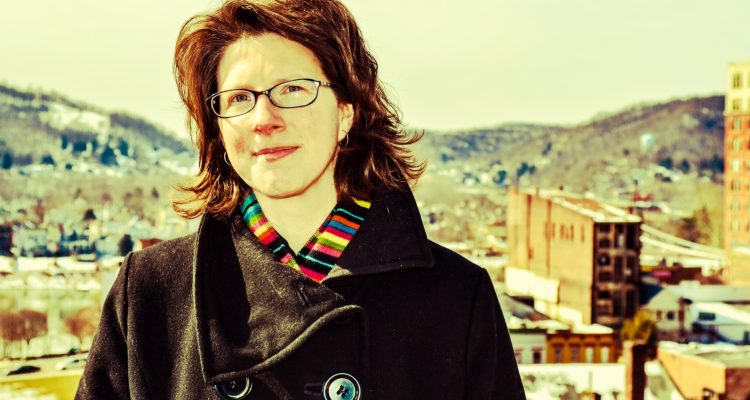If we can pretend for a moment that our brains are eggs-in-shells inside our heads, it would be easy to explain the injury suffered by Wendy Scatterday nearly three years ago.
If that’s the case, and we are pretending for just a moment, then Scatterday had her eggs cracked and scrambled.
At least that’s how it felt.
This 40-year-old lady was reduced to zero, to use her own words. An architect by day and community organizer in the evenings, Scatterday was forced to take a ride from which she wanted to jump. Instead, though, she used her more-than-a-year-long recovery time to reassess, to recalculate, and to synchronize her efforts to acquire a life she wanted most. Much to her own surprise, she emerged from the injury’s cocoon as a business owner, a venture she avoided during her professional career out of fright of the unknown.
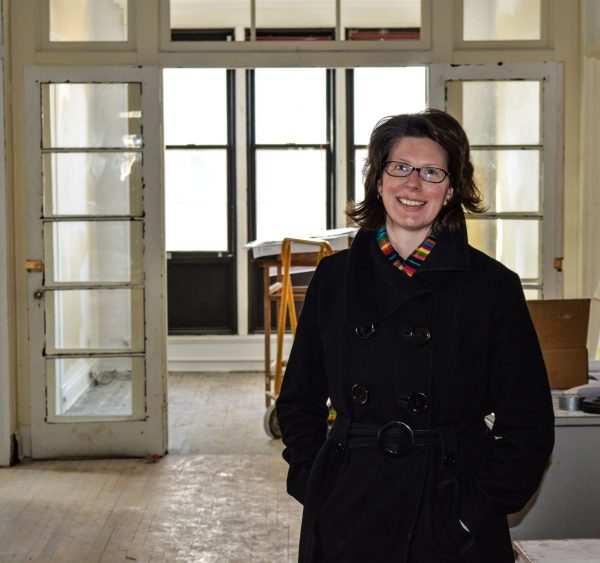
And Scatterday is doing it, and the phone keeps ringing.
Her road home to Wheeling also was an uncertain journey after graduating from Wheeling Park High School in 1990. She chose the University of Tennessee’s five-year architectural program, graduated in 1995, returned to her hometown, and could not find a job because no one was building anything. Instead, she returned to Oglebay Park to continue her minimum-wage, summertime work of “measuring toilets” (again, to use her own words) as part of an accessibility study the resort continues to implement today, and she even constructed a model on her bedroom floor for one local architect. Although she gained some part-time work from a few other firms, there was nothing concrete in Wheeling to keep her here.
So Scatterday left.
She lived in Pittsburgh for one year, and then in 1997 she moved to Connecticut close to her brother, Chuck, because an opportunity presented itself. But yet again, there were no promises made, and in the world of architecture the clock was ticking during the “internship” phase of the profession.
Scatterday needed to make a move – again – and she knew it.
New York City, Chicago, Philadelphia – wherever – were all possible city-scenarios, but that’s when she made a spur-of-the-moment phone call to Wheeling architect Victor Greco. Just when the Friendly City had faded in her mind, that conversation allowed Scatterday to secure employment in her hometown, and she was with the firm for 15 years until, of course, the brain-scrambling car crash.
But she is a Scatterday, and she is most proud to be the product of a community-minded clan. Her two brothers, Chuck and Chad, and her sister, Ashley, all live outside the area, but they come home often to see their mother, their father, and their sister. She is known as, “Nay-Nay” to her nieces and nephews, and Scatterday tries to be as active in their lives as possible.
This where Wendy wishes to be, and her injury taught her valuable lessons about the fragility of life and what she wishes to be included in that existence. She readily admits she’s following a path provided by The Almighty, and she couldn’t care less about how people feel about that fact that she pockets a wallet instead of carrying a purse or that her favorite shoes are a pair of steel-tipped boots and not four-inch heels.
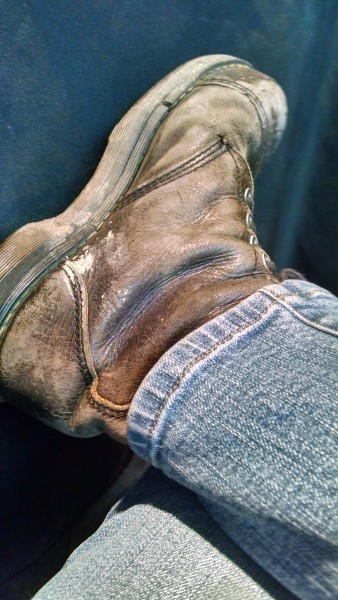
With those eggs now back in their shells, Wendy Scatterday is not only thinking clearly again, but her vision has never been better.
Novotney: As soon as you felt fully recovered from the concussion you suffered nearly three years ago, you decided to start your own business and open Scatterday Architecture. Tell me why.
Scatterday: That’s what I did, and I never wanted to own my own business. Ask anyone who knows me. I have been asked that question many times, and over and over again I’ve had to explain to people that I’ve never owned any interest in that. For me, it was more about feeling it was a burden and feeling like it was too risky. I just always thought it would be too much to the extent that my job security kept coming into my mind.
Everyone is employed at-will, but I definitely thought that I had more security being an employee than being self-employed, but what I understand now is that is false. Having the chance to be self-employed now has been an experience I did not expect. I never thought it would be like this. I literally had no idea it could be this great.
Novotney: What was the main reason why you decided to open your own business?
Scatterday: The fact that I had clients before I had the business.
Even though I was reluctant, the phone was ringing.
It was fear that held me back. There wasn’t one moment when I suddenly changed my mind. It’s been a process, and at first I had tell a bunch of folks that I could help them, but that I wasn’t an official business. I didn’t have the necessary insurance or any of that stuff. I was just Wendy. I had to tell people that I could help them, but they couldn’t sue me. Most of them didn’t have a problem with that.
By the time I got into the fourth project, I knew it was time to go get that insurance because the phone kept ringing. Once I finally made that decision and when I would tell people, they seemed more excited than I was. At that point, I was still so uncertain about it.
The truth is simple; despite the strength of my relationship with God, for 40 years I lived a half-life. When my car accident and the concussion stripped everything down from me, I had to be remade. I had to start over, and when you do that, you have nothing and have no idea where to turn. That’s when God said, “Turn to me, and I will take you places where you could never go on your own.”
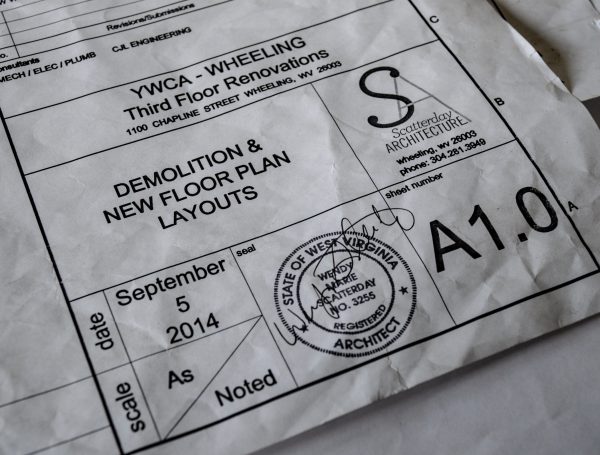
Novotney: What services does your firm offer?
Scatterday: I now have all of my professional liability insurances so I can do pretty much anything anyone needs me to do. I can now do commercial work, although I am not chasing that type of work.
My intent was to do all of the small, residential projects that I knew most of the firms in town would typically turn down because they were too small. Plus, I really enjoy that kind of work very much, and that is the bulk of the projects that I have now. Anything from a brand new home to a one-room addition to a kitchen renovation or a bathroom renovation, a porch addition, it’s a wide variety, and I absolutely love it.
Plus, I have a background on historic preservation so working on a project like the Wheeling YWCA is something I enjoy very much, too. Scatterday Architecture may be a new company, but I’ve been doing this work for almost 20 years now.
I have learned something new with every project, and that continues to be the case.
Novotney: Working on the YWCA has had to really open your eyes as to how Wheeling was built many years ago.
Scatterday: Without a doubt that’s been the case, and it’s been amazing for me because there are some buildings in Wheeling that I’ve always wondered about.
For every project you have to educate yourself about the client, the client’s needs, what they are hoping to achieve, and what their budget is. You also have to educate yourself on the structure involved. Every project is unique and doing your due-diligence on the front end is what I try to bring to the table as an architect.
That’s the art and science of architecture. You have to bring together the practical aspects and the technicalities of a place married with the needs and goals of the client. It’s a giant exercise of problem solving. That’s what I do for a living. I’m a problem solver. Give me a problem, and we’ll solve it.
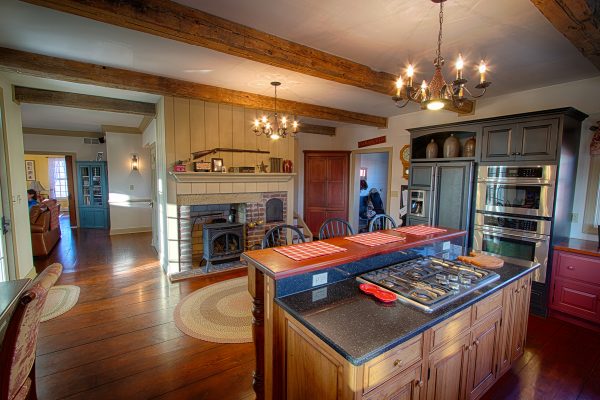
Novotney: Your father, Bob Scatterday, has always been very engaged with the Wheeling community. What are your thoughts about his efforts?
Scatterday: Our whole family, we’re givers. I think it comes from an understanding that life is not about you, and that’s how we all are. That’s our general disposition. We believe if we are in a community, we should be part of that community and to contribute to that community.
We’re all like that, and it’s always been that way.
Novotney: Why are you so involved with your community?
Scatterday: That’s hard to answer because it’s just the way I am. It’s how I was raised. It makes sense to me. Call me a Girl Scout. I really don’t know.
Community service is just a part of me. To me, I believe it’s our responsibility to give our time and talents away to make where we live a better place to live. It just makes sense to me because it makes everything better for everybody involved.
Novotney: A proposal to build on top of the hilltop that separates the Woodsdale and Gregsville neighborhoods led to the creation of a new organization known as “Woodsdale United,” and you played a big part with that.
Scatterday: The thing that I find more interesting is that it created itself. The first night that the issue was in the public arena there were 125 people that came to that meeting. They came on their own. There was no “Woodsdale United.” It happened after that.
Maybe a lot of people do not realize that. All I knew before that first meeting was that I was concerned, and so were five of my neighbors. We just went to that meeting, but we had no idea that 120 other people felt the same way. That was actually quite a surprise, and that’s when I had the realization that there were a lot of people concerned and that we likely needed a landing place.
That’s really when “Woodsdale United” came to be.

Novotney: Are you still concerned with what could be developed on that hilltop?
Scatterday: A property owner has the right to utilize their property within the regulations that are on the books. I respect that. We all do. As it is on the books, there is a public process that still applies to a development that would involve residential – public input is still a requirement.
As far as the hilltop specifically, the concern is a safety concern. When a development takes place, on that hilltop or any other hilltop, the safety and stability of the terrain are the primary concerns. That hilltop, in particular, already has a history of slips. The physics and the mechanics of moving dirt around in small ways or very large ways changes the physics and the geology of the place, and that’s not to be done without extreme care and caution, proper planning, and proper engineering.
There are maps that anyone can look up that show that the entire hillside – just like many of the other hillsides we have here in Wheeling – is a former mine site, and that means there are dual concerns – surface concerns and sub-surface concerns.
Novotney: Housing is just one of the needs we have here in Wheeling. What do you believe we can realistically fix in Wheeling?
Scatterday: Downtown is ready to go. There are so many opportunities here. Moving back in 1998 was a challenge, but there’s been a steady uptick that has me very encouraged about the future here. I don’t think there’s another city in the state of West Virginia that has greater potential than Wheeling. A lot of that has to do with our general proximity. We happen to be in a very strategic location. That does make us different, and then given our assets, resources, our workforce, and the people in our community who love it and would do anything to make it better makes up a combination that is unmatched.
It’s unmatched, and it’s all here, and it’s happening.
Novotney: I am sure you will remain involved with the Wheeling community, but what about with government? Have you ever thought about running for a public office?
Scatterday: I am on the board for the Wheeling National Heritage Area Corp., and I am on the board for the Greater Wheeling Coalition for the Homeless, and those are the things that are really near and dear to me.
It is also important to be active with my church, and I am still trying to figure out how to really engage that. One of the lessons I learned from my time off is that we are only as busy as we decide to be, and I’ve needed to make very specific decisions since recovering from the concussion I suffered in my car accident.
I see God’s wisdom in that, and whatever path He is going to lay out for me, I will follow. I don’t know what those paths are right now.
Novotney: Concussion injuries have attracted a lot of attention in recent years thanks to a lot of medical advancements, but many people still fail to pay much attention because such an injury has not had an impact on their lives.
Your life changed a great deal after you suffered a concussion in a car accident. Tell me about it.
Scatterday: March 6, 2012. I was driving, and another vehicle T-boned me on W/Va. Route 2 near John Marshall High School. It was a significant impact in terms of the force of the impact, and that’s what caused the injury. It was the severity of the force similar to Shaken Baby Syndrome.
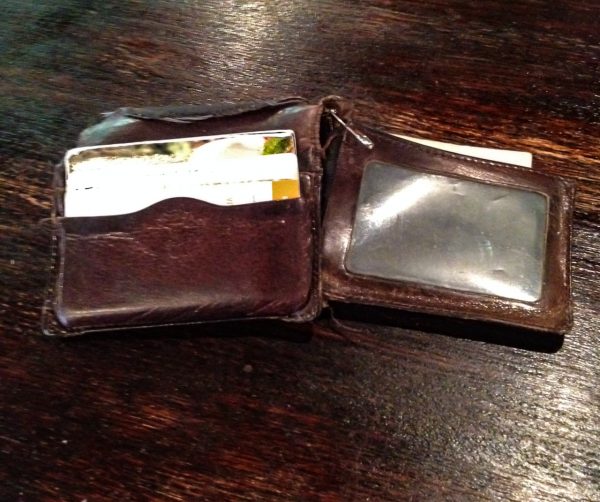
Novotney: Were you hospitalized?
Scatterday: I was not. I did go to seek medical attention, but the effects did not impact me until a few days later. There was a period of time when I was experiencing the concussion symptoms, but I did not know that I had suffered a concussion. I did not know what was wrong with me. I knew I didn’t feel right, but I had never been in a car accident, so I didn’t know how you were supposed to feel.
I felt run over, but I just thought it was normal.
Now I know that my brain was swelling, and it took some time for the full effect of that to really hit me. It wasn’t until the fifth day when the roller coaster started in full force.
It was awful. I’m not going to sugar-coat it. It was awful. It was very scary, and the uncertainty is gripping because there’s no knowable end point. And it took 14 months to end.
Novotney: Can you now offer advice to others who think they may have suffered a similar brain injury?
Scatterday: Maybe we should all be walking about with helmets on?
Barring that, maybe wrapping ourselves in bubble wrap?
I’m, of course, joking. I think the biggest advice I can give anyone is to use caution. If you suspect someone could be injured for whatever reason at all, I say use caution and get checked. We all only have one brain.


